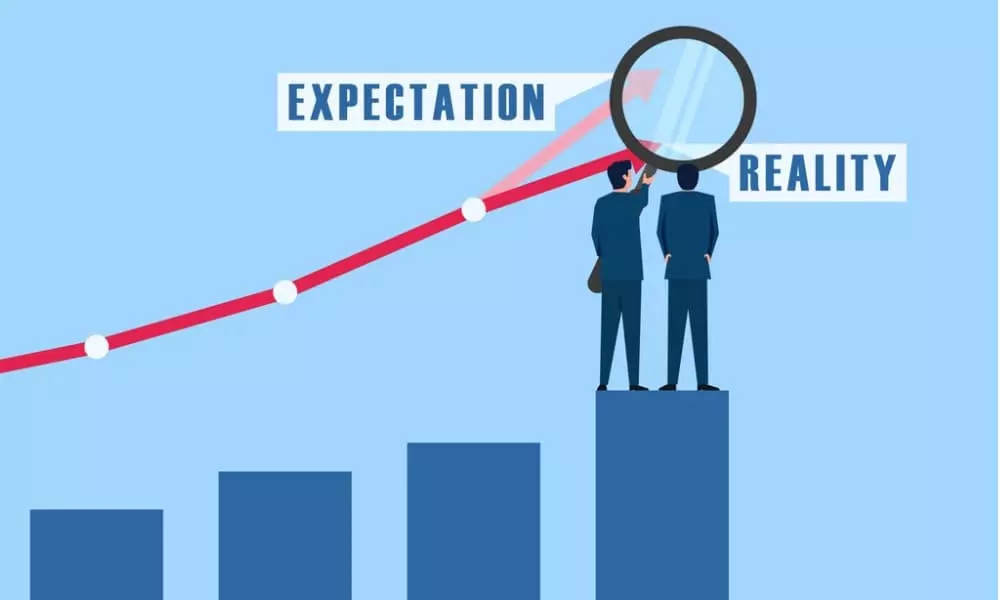Realistic results come from setting realistic expectations. Here’s how and why.
Key Takeaways:
- More than a third of employees are disengaged.
- A big factor is a lack of expectation clarity from their employers
- As leaders, we paint the picture. We must clearly communicate expectations – communication is critical to the process
- Employees who understand their role, contribute to the whole.
Unlike unrealistic goals, which can inspire creativity and innovation, unrealistic expectations harm work quality, raise stress, and lead to employee disengagement. As leaders, we must paint a picture for the organization by demonstrating where we’re going and embracing our roles as managers.
We have to share our thinking and our expectations. As business owners and entrepreneurs, we can empower our team by providing clear guidance rather than critiquing them for not meeting our expectations or assuming they understand our thoughts. If our teams don’t perform, we might say they’re not accountable or they’re not doing things correctly, when many times, it’s because we haven’t set the right expectations. Expectations need to be communicated; they can’t just be in our heads.
Employee disengagement is at 34% due largely to an employee’s level of agreement about expectation clarity. As leaders, we must continually reinforce expectations about the behaviors, roles, responsibilities, and results needed to drive the business. To get the best results, we need to paint the vision of what we want to create.
The power of setting the right expectations
When we don’t set realistic expectations, it has an impact on morale – employees live in fear of what their boss will or will not say about their performance instead of giving them clear expectations so they can know for themselves if they are doing a good job, had a good day, week, or year. They don’t have to wait for the boss to tell them.
Unrealistic expectations create resentment, misalignment, and communication gaps. Once the misalignment happens, expectations aren’t aligned, and communication becomes awkward. The more aligned the expectations, the better the conversations – and when employees have a clear understanding of our expectations, they can focus on their work to make meaningful contributions.
The pitfalls of unrealistic expectations
A big challenge entrepreneurs face is getting and keeping everyone in constant, consistent alignment. This alignment means everyone understands their role and how their work fits into the whole, working together to move the organization toward its goals. At the same time, leaders must know exactly what their teams are capable of and their strengths and weaknesses to deliver consistent results.
Unrealistic expectations don’t deliver realistic results and have short and long-term consequences, including
- Missed delivery dates,
- Reduced work quality
- Cost overruns
- High absenteeism
- Low morale
- High staff turnover
If expectations are set too high, employees will consistently fail to meet them, no longer trying their hardest. Always asking for the impossible can also cause us to lose the respect of our teams.
Setting expectations
The role of leadership in creating a vision is crucial for helping others understand why they need to achieve specific goals. This vision sets a clear direction for the company’s future and the reasons behind it. Sharing “the why” is incredibly important.
There’s a famous story about President John F. Kennedy’s first visit to the NASA space center. The president saw a janitor carrying a broom and stopped his tour to ask, “What are you doing?” The janitor responded, “Well, Mr. President, I’m helping to put a man on the moon.”
This story illustrates how seeing the larger purpose, rather than just the daily tasks, increases employee engagement and satisfaction, serving both their personal and the organization’s goals. Our goal as leaders is to make employees understand how their roles and responsibilities affect the vision.
Of course, external factors affect expectations, including market fluctuations, changing trends, and competitive landscape. As leaders, we must be aware of these macro variables to adjust expectations accordingly.
Company culture is essential, too. If your company has a strong culture built on shared values, beliefs, and practices, employees will understand how we, as leaders, will respond to a given situation. Our teams will appreciate our response and know that it aligns with the company’s culture.
How to set realistic expectations
If you want realistic results, create a transparent company with clear communication and expectations. This formula builds a positive company culture because everyone understands how they should behave. It also instills clear accountability. People want predictability and don’t like uncertainty, so setting clear expectations in the short term helps manage long-term change.
Who recommends, who agrees, who performs, who gives input, and who decides? Having clarity about these things helps employees understand the expectation. Data-driven insights are also important when setting employee expectations. When tied to data, objectives are measurable against organizational goals. Data also gives you clear metrics for evaluating performance.
Effective communication plays a pivotal role in establishing and overseeing expectations within an organization. In addition to the crucial aspects of feedback and dialogue, incorporating powerful tools such as the quarterly state of the company address and Level 10 meetings can significantly enhance this process. Incorporating these two elements serves as a robust mechanism to fortify communication efforts and are invaluable in facilitating alignment between managers and team members. Be sure these sessions focus on aligning values, defining necessary roles, and making clear the metrics and results contributing to the overall organizational vision.
Be flexible and adaptable
Mike Tyson said, “Everyone has a plan until they get punched in the mouth.” We live in constant change, and we need to develop a “muscle memory” that we can rely on when things don’t go as planned. We need to be agile and understand that expectations might take a hit. If we’ve communicated effectively and promoted a strong culture, we can pivot and determine changes that will get realistic results.
Both leaders and employees must understand when we need to pivot and why. There should be a fluid conversation about expectations and potential roadblocks, and a cadence of understanding should be developed. What’s not going to be met? Why? Do we need to do something new? What will be affected?
Communication is critical to the process
The key is an aligned conversation so everyone knows the implications: what will happen? Feedback and expectation management are crucial, so we need promote a consistent message. We benefit most when the conversation includes full feedback, healthy conflict, directness, and clarity.
Brenė Brown says, “Clear is kind.” We cannot have a culture where things are swept under the rug or don’t speak up because they are afraid of stepping on someone’s toes. We need constructive feedback, healthy conflict, and for people to be direct. We must all be reassessing and re-engaging about what needs to be done.
Feedback is important to recalibrate expectations, performance, and behaviors. In short, feedback is critical for setting the right expectations. But, feedback has to be bi-directional–top down and bottom up. All parties need to be aligned in constantly receiving and giving feedback to align expectations and move forward together if the expectation is realistic results.
Celebrate the wins
Many times, as leaders, we miss opportunities to acknowledge success. We need to remember that we always have more to do, but we need to come from the mindset of gain and not the gap. As Dan Sullivan calls it, “The gain of the gap.” As leaders, we should pause to celebrate the wins before focusing on the next thing that needs to be done.
So, always celebrate the wins, give proactive feedback, recognize in public, and criticize in private. One of the benefits of managing expectations effectively is that people understand their place in the company, how their role affects the vision, and how they should perform.
At the Profit Recipe, we’ll work with you to understand and develop the leadership skills you need for success. We’ve been there, done that, and learned valuable lessons that we’re eager to share. Join our community of entrepreneurs and share your experiences to help yourself and others navigate the purposeful leadership journey.
We’re here for you and because of you. Let us support your entrepreneurial journey – schedule a call with one of our experts today or send us a message.



